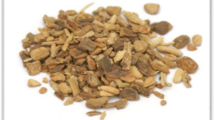Abstract
The present study was carried out to evaluate the hypoglycemic, lipid lowering and antioxidant activities in root extract of Anthocephalus indicus (A indicus) in alloxan inducd diabetic rats. Oral administration of ethanol extract of root (500mg/ kg body weight) for 21 days resulted in significant decrease in the levels of blood glucose, triglycerides, total cholesterol, phospholipid and free fatty acids. Furthermore, the root extract (100–400μg) inhibited the generation of superoxide anions and hydroxyl radicals, in both enzymic and non-enzymic systems, in vitro. The result of the present study demonstrated hypoglycemic, lipid lowering and antioxidant activities in root extract of A indicus, which could help in prevention of diabetic dyslipidemia and related diseases.
Similar content being viewed by others
References
Jain SK, De Fillips RA. Anthocephalus indicus: In Medicinal plants of India. Reference publication Inc.; Algonac, Michigan, 1991;2:515–516.
Sircar NN. Pharmacological basis of Ayurvedic therapy. In cultivation and utilization of medicinal plants. Atal CK, Kapoor BM eds. Publication and information Directorate, CSIR, New Delhi, India, 1992:507–518.
Brown RT, Fraser SB, Banerji J. Heart wood of Cadamba contains glucoalkaloids of isodihydrocadambine. Tetrahedran Letters 1974, 29:3335L.
Brown RT, Chapple CL. Anthocephalus alkaloids: 3α — dihydrocadambine and 3β — isodihydrocadambine. Tetrahedran Letters 1976, 31:2723–2724L.
Sahu NP, Mahto SB, Banerji N, Chakravarti RN. Cadambic acid. A new triterpenic acid from Anthocephalus cadam. Ind J Chem 1974;17:284–286.
Chandra O, Gupta D. A complex polysaccharide from the seeds of Anthocephalus indicus. Carbohydrate Res 1980;83:85–92.
Chopra RN, Nair SL, Chopra IC. Anthocephalus indicus. In Glossary of Indian Medicinal Plants. Eds; Publication and Information Directorate, CSIR, New Delhi, India, 1956;p 20.
Paranjpe P. Indian Medicinal Plants, Forgotten Heales, A guide to Ayurvedic Herbal Medicine, Chaukhamba Sanskrit pratishthan, Delhi, India, 2001:112–113.
Kumar V, Singh S, Khanna AK, Khan MM, Chander R, Mahdi F, Saxena JK, Singh R, Singh RK. Hypolipidemic activity of Anthocephalus indicus (Kadam) in hyperlipidemic rats. Medicinal Chemistry Research 2008;17:152–158.
Kumar V, Khan MM, Khanna AK, Singh R, Singh S, Chander R, Mahdi F, Mahdi AA, Saxena JK, Singh RK. eCAM 2008, DOI L:10.1093/eCAM /nen001.
Ragavan B, Krishna Kumari S. Antidiabetic effect of T. Arjuna Bark extract in alloxan induced diabetic rats. Ind J Clin Biochem 2006, 21(2):123–128.
Trivedi NA, Mazumdar B, Bhatt JD, Hemavathi KG. Effect of Shilajit on blood glucose and lipid profile in alloxan induced diabetic rats. Ind J Pharmacol 2004, 36(6):373–376.
Pavana P, Sethupathy S, Manoharan S. Antihyperglycemic and Anti lipid peroxidative effect of Tephrosis purpura seed extract in streptozotocin induced diabetic rats. Ind J Clin Biochem 2007;22(1):77–83.
Rao BK, Kesavulu MM, Apparao C. Evolution of antidiabetic effect of Momordica cynobalaria Fruit in alloxan diabetic rats. J Fitoterapia 2003;74:7–13.
Schweitzer M, Tessir D, Valhos WD, Leiter L, Collet JP, Moqueen MJ, Harvey L, Alaupovic FA Comparison of pravastatin and gemfibrozil in the treatment of dyslipoproteinemia in patients with non insulin dependent diabetes mellitus. J Atherosclerosis 2002;162:201–210.
Al-Awadi FM, Kattar MK, Gumma KA. On the mechanism of the hypoglycemic effect of a plant extract. Diabetologia 1985;28:432–434.
Trinder P. Determination of glucose in blood using glucose oxidase with an alternative oxygen acceptor. Ann Clin Biochem 1969;6:24–30.
Zlatkis A, Zak B, Boyle AJ. A new method for the direct determination of serum cholesterol. J Lab Clin Med 1953;41:486–492.
Zilversmit DB, Davis AK, Memphis B, Tenn N. Estimation of phospholipids in biological fluids. J Lab Clin Med 1950;35:155–160.
Van Handel E, Zilversmit DB. Micromethod for direct determination of serum triglycerides. J Lab Clin Med 1957;50(1):152–157.
Mosinger F. Photometric adaptation of Dole’s microdetermination of free fatty acids. J lipid Res 1965;6:157–159.
Bindoli A, Valante M, Cavallin L. Inhibition of Xanthine oxidase and xanthine dehydrogenase activity. Pharmacol Res Communication 1985;17:831–839.
Mc Cord JM, Fridovich I. Superoxide dismutase, an enzyme function for erythrocuprin (hemocuprin). J Biol Chem 1969;244:6049–6055.
Richmond R, Halliwell R, Chauhan J, Darbre A. Superoxide dependent formation of hydroxyl radicals by hydroxylation of aromatic compounds. Anal Biochem 1981;118:320–335.
Halliwell B, Gutteridge JMC, Arouma OI. The deoxyribose method: a simple test tube assay for determination of rate constants for reaction of OH- radicals. Anal Biochem 1987;165:215–219.
Woodson RF. In: Statistical Methods for the Analysis of Biochemical Data. Chichester: Willey. 1987;315.
Al- shamaony L, Al- Kharaji SM, Twaij HA. Hypoglycemic effect of Artemisia herba alba.11. Effect of a valuable extract on some blood parameters in diabetic animals. J Ethnopharmacol 1994;43:167–171.
Rhoads GG, Gulbrandse CL, Kagan A. Serum lipoproteins and coronary artery disease in a population study of Hawaiian Japanese men. New Eng J Med 1976;294:293–298.
Stanley P, Prince M, Menon VP. Hypoglycemic and hypolipidemic action of alcohol extract of Tinospora cordifolia roots in chemical induced diabetes in rats. Phytother Res 2003;17:410–413.
Ceriello A. New insights on oxidative stress and diabetic complications may lead to a “Causal” antioxidant therapy. Diabetes care 2003;26:1589–1596.
Bloomgarden ZT. Aspect of blood pressure, lipid and glycemic treatment Diabetes Care 2004;27:264–269.
Author information
Authors and Affiliations
Corresponding author
Rights and permissions
About this article
Cite this article
Kumar, V., Khanna, A.K., Khan, M.M. et al. Hypoglycemic, lipid lowering and antioxidant activities in root extract of Anthocephalus indicus in alloxan induced diabetic rats. Indian J Clin Biochem 24, 65–69 (2009). https://doi.org/10.1007/s12291-009-0011-4
Published:
Issue Date:
DOI: https://doi.org/10.1007/s12291-009-0011-4




